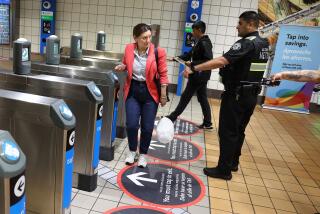Road safety isn’t as simple as saying ‘Click it or ticket’
- Share via
Los Angeles motorists, as well as others around the nation, are being treated to an intensive period of ticketing, thanks to a $30-million program by the federal government.
“Click it or ticket,” say the electronic signs on major Southern California freeways, broadcasting the annoying advertising slogan adopted by the National Highway Traffic Safety Administration. In L.A. County, those tickets cost between $69 and $181.
Wearing seat belts is obviously responsible and sane behavior, which if faithfully followed by every occupant of every vehicle could save many thousands of lives and prevent more permanently disabling injuries.
But is a program by the federal government to exert pressure on state and local police to issue tickets -- accompanied by what amounts to ticket quotas -- the right approach, particularly at a time when police are not able to fully control speeding, drunk driving and aggressive driving?
There are compelling reasons to increase seat belt usage, particularly among young drivers and particularly among men. Many experts believe the best way to do that is through education and advertising.
One of the most effective ads ever to promote seat belt use was released in recent weeks by New Jersey Gov. Jon S. Corzine, who was gravely injured April 12 while riding in the front passenger seat of a sport utility vehicle going more than 90 mph. Corzine was not wearing a belt.
“I am New Jersey Gov. Jon Corzine and I should be dead,” he says in the ad. Only a series of miracles saved his life, “when all I needed was a seat belt. I have to live with my mistake. You don’t. Buckle up.”
What I like about this approach is the compelling message of a powerful person admitting his misjudgment. Corzine did not make an implicit threat of handing out tickets either. What I don’t like about the ad is that the real problem in the crash was the state trooper at the wheel going 90 mph; nothing was said about that.
A cabal of powerful federal and state agencies has erected a ticket writing machine with some problematic inconsistencies. In recent years, NHTSA has not conducted an equally coordinated, high profile effort to ticket aggressive driving, street racing or extreme speeding.
The current campaign includes police checkpoints, where motorists are stopped and examined for compliance with mandatory seat belt laws. Such random stops have been permitted by the Supreme Court for sobriety checkpoints, based on the public threat posed by drunk drivers. But I’m not aware of a similar ruling on checkpoints for belts.
NHTSA is acting increasingly authoritarian. Its public affairs officers begin each conversation with the media with the disclaimer, “This is off the record.” The only person allowed to speak publicly at the agency is its chief, Nicole Nason, previously a lawyer for several federal agencies and a life insurance company, who seldom grants interviews.
Sweeping authority is an opportunity for abuse, some experts say.
“I am an advocate for seat belts,” said Chad Dornsife, head of the Best Highway Safety Practices Institute, a nonprofit organization based in Nevada. “But advertising programs have more effect on people than tickets. The problem is police are doing it for the money.”
Dornsife cites grant documents for NHTSA funding to states that specifically set ticket writing standards.
Take, for example, the performance measures set up by Massachusetts, as well as many other states, under its seat belt enforcement grant.
“The intent of each patrol is to generate documented stops,” it says. “Informational handouts may be distributed, but should not take the place of a citation or warning. A minimum of three documented stops per hour is the suggested law enforcement activity under this grant program.”
Civil rights organizations have long seen seat belt laws as giving police carte blanche authority to make racially motivated traffic stops, as well.
“All the police have to do to make a pretext stop is say, ‘I didn’t see your seat belt,’ ” Dornsife says.
You might ask, “If seat belts are so critical, then why has the federal government not taken stronger action to require them in school buses?” Training young kids to buckle up in a school bus would create a practice that could continue once those kids began to drive.
The other troubling inconsistency with the “Click It or Ticket” campaign is what it says about the government’s right to intervene in risky behavior that mainly affects the individual.
If the federal government has the authority to stop risky behavior, can it move on to smoking, mountain climbing, alcohol consumption and gun possession?
Seat belts should be required by law, but the enforcement priority placed by the federal government should be on illegal behaviors that threaten the safety of other motorists, including running red lights, extreme speeding, street racing, drunk driving and other deliberate acts.







